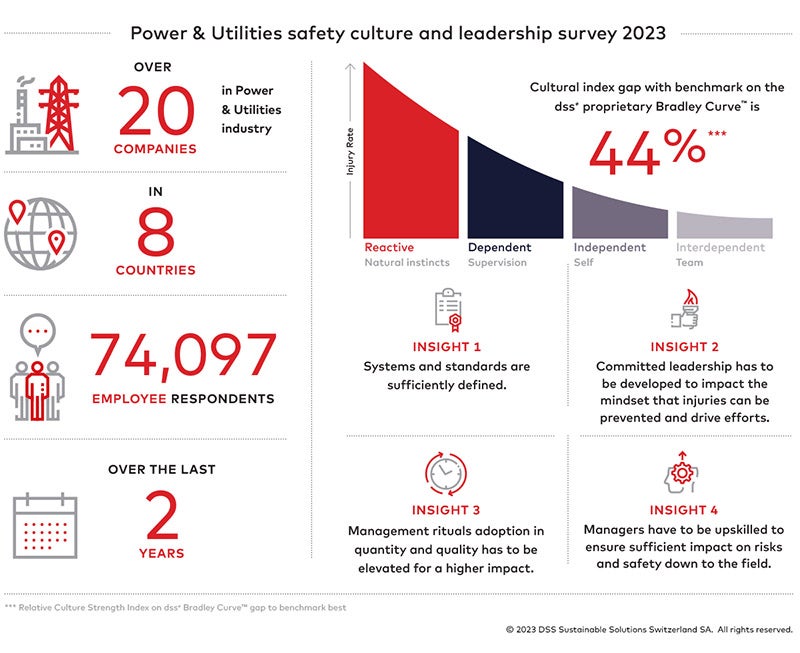dss+ is a Business Reporter client.
Rapid transformation in the energy and utilities sector offers exciting opportunities and significant operational challenges.
Rapid transformation in the energy and utilities sector is exposing businesses to new risks, including serious injuries and fatalities (SIF), which, unless challenged, will undermine confidence in their ability to manage risks and be competitive.
But the transformation also reveals important business opportunities: new supply chains, rapid hiring and an increase in outsourced work. Added to this is the transition towards new energies and technologies, and different operating models.
Organizational footprints are also changing, with companies building or acquiring new assets while maintaining old ones. More workers and contractors are now working remotely as well. Consequently, managers struggle to implement operating standards, enforce operational discipline, and ensure safe operating procedures. The result is a worrying increase in FIS.
The pressure to transform at pace means companies fail to anticipate and address the changing reality of construction jobs and operations. Workplace injuries demonstrate how difficult it is to meet demands for change while maintaining standards.
So how can SIFs be prevented? And how can companies prepare for the future?
Risk profile
The key is to understand the risk profile of current and future operations: identify the main risks, prioritize prevention actions and raise awareness of the critical security barriers and controls necessary to ensure a robust and effective implementation.
The infographic below confirms that managers are struggling to develop an understanding of risk profiles and to raise awareness and focus at the right level down to operations.
The conventional approach of risk suppression, reduction and mitigation is not sufficient to address the changing nature and magnitude of risks. Managers must develop their ability to recognize risks and focus their efforts on the most critical ones. The high pace of transformation, lack of time, complexity and fragmentation of some organizations now demand excellence in focusing the time dedicated to security; more specifically, the time spent on critical risks.
Efficient improvement or retraining
In addition to improving their own ability to understand and anticipate the risk profile of operations, managers and leaders must work to elevate company culture and impact mindsets and behaviors by demonstrating engaged leadership.

Therefore, capacity development for leaders and managers should be accelerated. Improving the capabilities of managers now will help them cope with the future demands of the energy transition and the important transformations needed to achieve Europe's net-zero emissions targets.
Managers, particularly the most capable, are already a scarce resource, with most already dealing with multiple business and operations transformation initiatives. Therefore, mobilizing them on a path to improve safety performance only works if it is done efficiently.
It is about providing them with efficient and impactful support in daily life, during their management rituals, improvement initiatives and field interactions, and at any time they seek to impact the mentalities and behaviors of their teams on key risks.
dss operations management consultant+ recommends that on-site training be the center of the safety performance improvement process. This will ensure efficiency, rapid upskilling and sustainable high impact.
Speed up impact time
Companies must address SIFs quickly. However, identifying and implementing actions while navigating organizational complexity is difficult.
A strong push from the top can mobilize and stimulate the entire organization, but a well-designed and implemented program that is personalized and structured is also required.
dss+ helps companies focus on specific areas of the organization (a business process, a technology, a team, etc.) to optimize and accelerate the transformation process.
a recent dss+ A sample of 12 large safety transformation programs involving more than 25,000 managers showed that a 24-week upskilling or reskilling program enables companies to reverse the trend of declining safety performance and achieve the autonomy needed to deliver results. sustainable.
The approach begins with a quick diagnosis of the situation, confirming the areas and risks to focus on and the key actions required. Then engage leadership with implementation decisions and visible actions, before supporting deployment.
Four key actions to start your transformation
Surface the burning platform
It is important to observe not only the obvious events but also the low intensity signals: increased number of near misses, production losses, poor management reaction to unsafe acts, etc. Furthermore, actual KPI trends reveal little about the future risks that organizations will have to face. Managers must develop the ability to anticipate future risk profiles.
Articulate the business case in the boardroom
Sizing results and developing the business narrative that supports the opportunity to launch a security transformation program is a prerequisite for alignment and further acceleration. In this sense, many companies analyze the possible savings derived from reducing incidents, but underestimate the strategic benefits they can obtain in terms of operational excellence, predictability, attractiveness and competitiveness.
Evaluate current initiatives and capabilities.
Organizations should review current improvement initiatives and determine whether they will produce the expected results. They should also analyze internal HSE capabilities and consider organizational adjustments to achieve closeness and level of support. If the speed, depth of change, and nature of support required exceed capabilities, they will need external support.
Identify success factors
These include a strong sense of purpose and forward momentum, as well as tailoring deployment strategy and support to each specific perimeter. For these types of initiatives aimed at managers, critical mass considerations are important. The first signs of improvement are visible when a critical mass of 25 percent of managers are trained or retrained; To achieve sustained impact, this critical mass must be increased further and maintained above 75 percent.
Recognizing and addressing challenges in security management is essential and provides strategic benefits. dss+ recognizes the challenges energy and utility companies face in adapting to changing demands while addressing growing SIFs. We offer clients our expertise in management upskilling and retraining programs, with the goal of equipping them with the tools to not only manage the evolving business landscape, but also to achieve meaningful business transformation.
For more information visit consultadss.com.

Mathieu Leduc, Regional Director of Europe: Energy and Public Services










